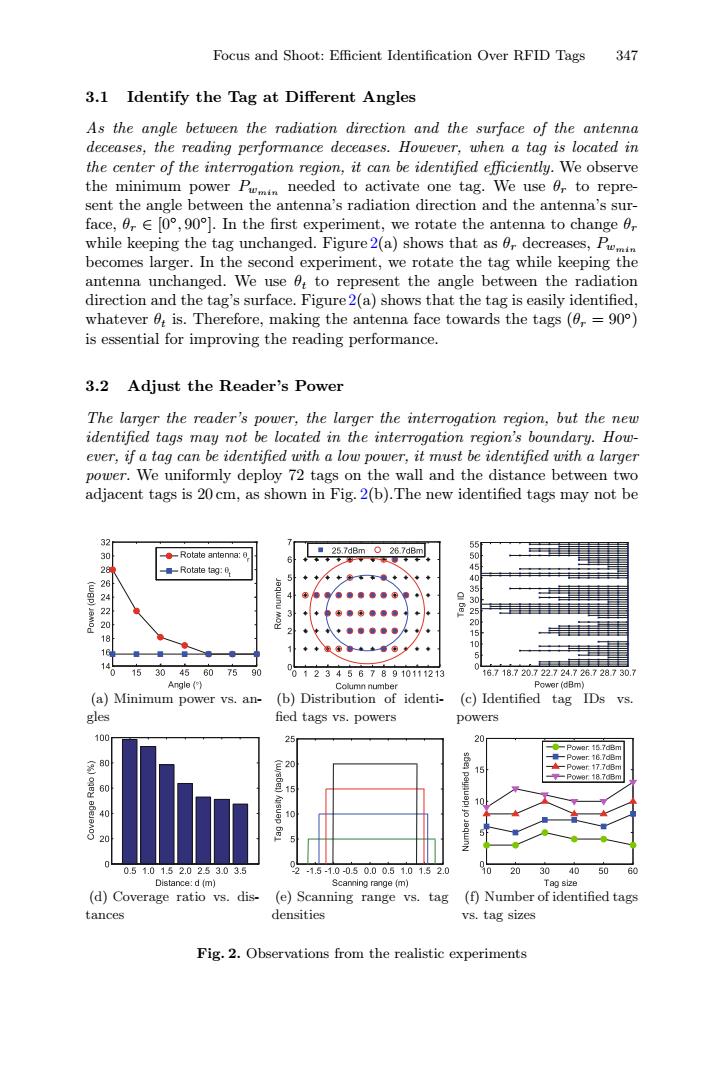正在加载图片...

Focus and Shoot:Efficient Identification Over RFID Tags 347 3.1 Identify the Tag at Different Angles As the angle between the radiation direction and the surface of the antenna deceases,the reading performance deceases.However,when a tag is located in the center of the interrogation region,it can be identified efficiently.We observe the minimum power P needed to activate one tag.We use 0r to repre- sent the angle between the antenna's radiation direction and the antenna's sur- face,6r E[0,90].In the first experiment,we rotate the antenna to change while keeping the tag unchanged.Figure 2(a)shows that as r decreases,Pm becomes larger.In the second experiment,we rotate the tag while keeping the antenna unchanged.We use 6:to represent the angle between the radiation direction and the tag's surface.Figure 2(a)shows that the tag is easily identified, whatever 0:is.Therefore,making the antenna face towards the tags(0,=90) is essential for improving the reading performance. 3.2 Adjust the Reader's Power The larger the reader's power,the larger the interrogation region,but the new identified tags may not be located in the interrogation region's boundary.How- ever,if a tag can be identified with a low power,it must be identified with a larger power.We uniformly deploy 72 tags on the wall and the distance between two adjacent tags is 20 cm,as shown in Fig.2(b).The new identified tags may not be ●-Rotate antenna:g ■25.7dBm026.7dBm 50 ◆ -Rot妇teeg:0, 45 2 9 35 2 25 10 1 15 30 4560 75 90 012345678910111213 16.718.720.722.724.726.728730.7 Angle ( Column number Power (dBm) (a)Minimum power vs.an- (b)Distribution of identi- (c)Identified tag IDs vs. gles fied tags vs.powers powers 100 2 20 220 er:17.7dBr -Power 18 7dBn 60 10 40 0.51.01.52.0253.03.5 2-1.5-1.0-0.50.00.51.01.52.0 102030405060 Distance:d (m) Scanning range (m) Tag size (d)Coverage ratio vs.dis-(e)Scanning range vs.tag (f)Number of identified tags tances densities vs.tag sizes Fig.2.Observations from the realistic experimentsFocus and Shoot: Efficient Identification Over RFID Tags 347 3.1 Identify the Tag at Different Angles As the angle between the radiation direction and the surface of the antenna deceases, the reading performance deceases. However, when a tag is located in the center of the interrogation region, it can be identified efficiently. We observe the minimum power Pwmin needed to activate one tag. We use θr to represent the angle between the antenna’s radiation direction and the antenna’s surface, θr ∈ [0◦, 90◦]. In the first experiment, we rotate the antenna to change θr while keeping the tag unchanged. Figure 2(a) shows that as θr decreases, Pwmin becomes larger. In the second experiment, we rotate the tag while keeping the antenna unchanged. We use θt to represent the angle between the radiation direction and the tag’s surface. Figure 2(a) shows that the tag is easily identified, whatever θt is. Therefore, making the antenna face towards the tags (θr = 90◦) is essential for improving the reading performance. 3.2 Adjust the Reader’s Power The larger the reader’s power, the larger the interrogation region, but the new identified tags may not be located in the interrogation region’s boundary. However, if a tag can be identified with a low power, it must be identified with a larger power. We uniformly deploy 72 tags on the wall and the distance between two adjacent tags is 20 cm, as shown in Fig. 2(b).The new identified tags may not be (a) Minimum power vs. angles (b) Distribution of identi- fied tags vs. powers (c) Identified tag IDs vs. powers (d) Coverage ratio vs. distances (e) Scanning range vs. tag densities (f) Number of identified tags vs. tag sizes Fig. 2. Observations from the realistic experiments